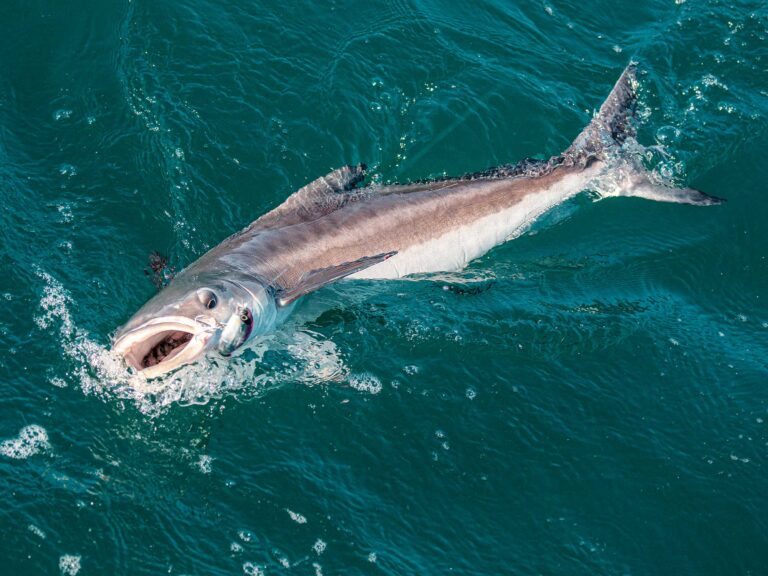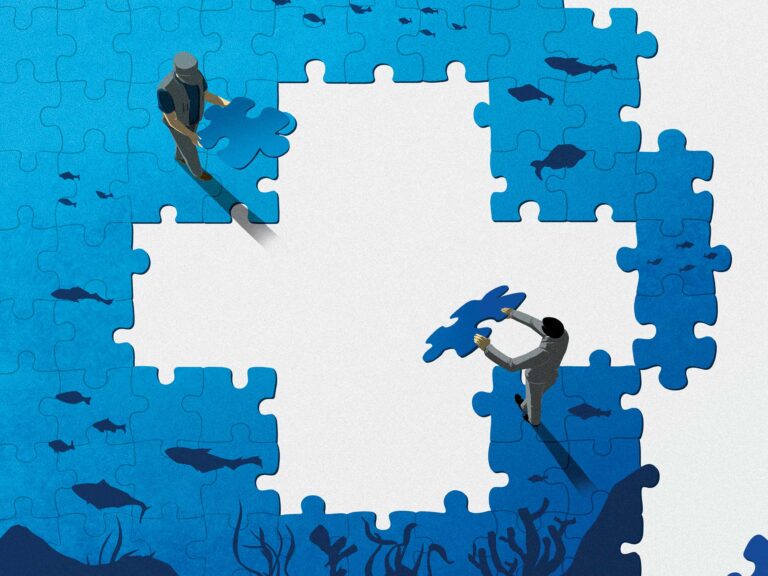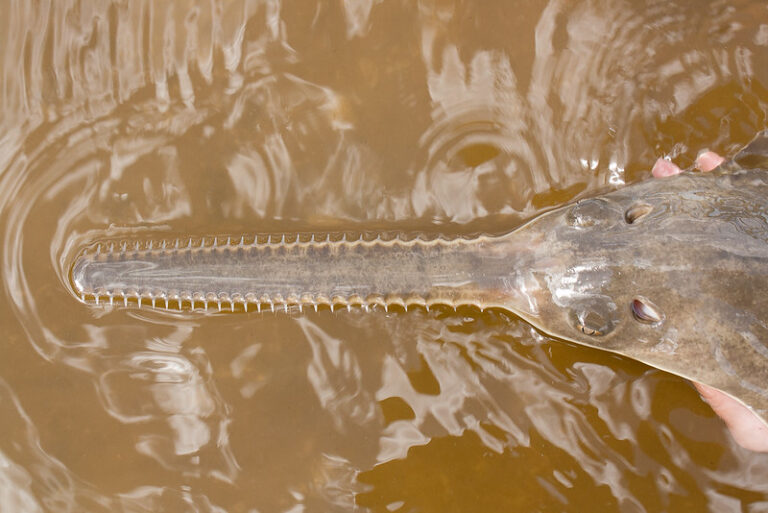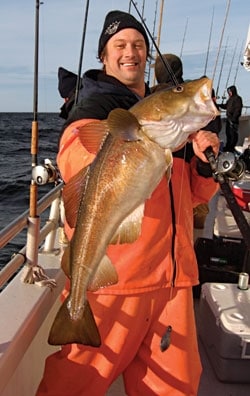
We were loaded, if not for bear, at least for anything with fins that might swim under us in the Gulf of Maine. We had commandeered the Airmar company boat for a day of sounder and transducer experimentation, and what better place for that than the storied grounds of Jeffreys Ledge.
Don Kinnett, Airmar’s new-products coordinator, was at the helm as we headed out Piscataqua River against a fierce tidal current, and Airmar’s Mark Reedenauer and I switched and cross-switched a formidable array of fish finders wired through selector switches to a full selection of transducers.
It was a perfect gray Maine day as we cruised through the Isles of Shoals and headed 25 miles off the coast for Jeffreys Ledge, the legendary cod, pollock and haddock ground in this part of the world. It’s not a bad place for bluefin tuna either, but that’s another story.
Gulf Signature
Jeffreys Ledge runs northeasterly off the shoals of Cape Ann, Massachusetts. Technically, it is about 20 miles long and about 4 miles wide. The depth of the bank runs from 150 to slightly more than 200 feet, falling off to 300 and 400 feet at the edges. Though a small piece of geography in the expanse of water that is the Gulf of Maine, it occupies a significant role in the region’s fishing. “It is a substantial part of the fishing around here,” says Mike Cleary, who captains the charter boat Scout out of Portsmouth, New Hampshire. “It gathers and holds the bait, and it is important structure. Without it, the fishing around here would be much different.”
**Abundant Structure
**The 25-mile run from Portsmouth to Jeffreys is peppered with other productive structure, Cleary explains: “We have great humps between here and there, spots we stop and check on the way out to Jeffreys, such as the Outer Flag, Inner Flag, Old Scantum – they are about 12 to 14 miles out. These are humps that come up to 180 feet of water, out of 400 feet.”
These humps are easy to plot. Even on the NOAA1:500,000 small-scale Gulf of Maine chart 13009 they stand out with dramatic relief, rising from 55 to 28 fathoms. When prospecting for groundfish, Cleary uses his sonar to find the structure first. “I use my electronics to navigate to a spot on the structure that I know holds fish,” he says. “I start by zooming in tight on the bottom and looking for any separation from the bottom, and specifically looking for bait and marking the schools.”
Once he finds marks he thinks will be productive, he checks the wind and current along the structure and sets out a sea anchor to slow the drift. “If it is productive, I’ll go back and drift it again,” Cleary says. He’ll cover a productive edge until it plays out, then find another. “I may move 25 times in a day,” he says. “Rarely does one spot produce all day, so you might get half a day out of one spot and then go look around for another.”
In this fishery, success is measured not in fish but in pounds of fish. “On good days, we’ll get a couple of boxes of cod, haddock, and pollock – 150 or 200 pounds, and you can have 400-pound days,” Cleary says. “But then there are days when you are lucky to get 50 pounds. If it’s a tough day, I’ll go fish the cusk in the rocks. They always bite.”
Theory Into Action
Kinnett backed off the throttles as Reedenauer and I watched the edge of Jeffreys climb the side of the fish finder screen, from 400 feet to just under 200. We weren’t fishing totally blind, as there was an icon posted atop Jeffreys Ledge on the chart plotter, a little knife and fork sitting in the middle of the ledge in 190 feet of water. Kinnett checked the drift, motored a bit upwind of the little knife and fork and cut the engine, and we were fishing.
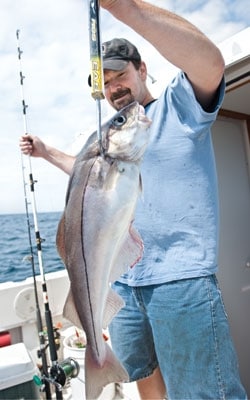
Cod fishing on Jeffreys Ledge is often a less-than-technical exercise. A heavy attractor lure on 80-pound leader, a dropper with a healthy helping of fresh clams, and 50-pound-test on conventional gear dropped to the bottom is often as complicated as it gets. Before deploying the first rig, we scoured the fish finder screens for clues. It was strictly crickets. Zip. Blank screens all around. Not a sign, not even a promising unevenness on the bottom to hint at cod lying tight to the seafloor. We dropped the baits over anyway and hadn’t drifted far when Reedenauer’s rod bent double; 200 feet of line later, one of the more outlandish things I have ever seen with a hook in its mouth came over the gunwale.
Regulars of these waters recognize wolffish for what they are: an especially toothy, and unbelievably ugly, regular occurrence when groundfishing in these parts. To an out-of-towner like me, they can be a shock, but also a welcome catch, Kinnett assured me, as these fish go for up to $20 a pound in local markets. On an early-morning fishing trip, I’d probably be willing to pay that much not to have to look at one of them, but local knowledge carried the day, and the wolffish took up residence on ice.
Low-Tech
As we drifted, a mixed bag of cod, haddock and pollock kept making liars of the fish fin-ders. The cod weren’t the bruisers that typically show up earlier in the season and later in the winter, but they were welcome nonetheless. Detecting hits is a knack that comes quickly, but it’s essential in 200 feet of water, where you’d rather not reel up unless there’s a fish on the line. The rigs we drifted were simple but still pretty well-prescribed by the local pros.
Capt. Joshua Kardos, of the Yankee Fleet, targets the cod, pollock and haddock on the southern end of Jeffreys out of Gloucester, Massachusetts, and he explained the proven partyboat setup. “We rig with 5 feet of 80- to 100-pound leader attached to 50-pound line,” Kardos said. “We fish any Norwegian-style jig 12 to 24 ounces or a diamond jig, hammered or smooth on the bottom, and two feet or so above that, a 2-foot dropper loop with some type of teaser: grub tails, flies, soft-plastic lures like Slug-Gos, or 5-inch Kalin’s grubs – it doesn’t matter much.”
Kardos recommends attaching the leader to the end of the line with a snap swivel for quick leader replacement. “If you get two fish on at once, they’ll bust the rig apart,” he says. To that basic recipe, we added fresh clams on the dropper on a 6/0 hook a couple of feet above a metal jig, a crippled herring in this case. It seems the color, style and brand of terminal tackle aren’t important so long as the necessary functions are fulfilled. On this day, that meant getting the rig on the bottom. Not near the bottom, not a couple of winds above the bottom, but right smack on the gravel.
The breeze stayed steady, and when the bites on one drift slowed, we motored back up the line and started again. Conditions were so consistent that the plots on our consecutive drifts ran virtually on top of one another. The cod were there, though you wouldn’t have known it by the fish finders. The screens stayed blank all day. The bottom looked good, the resolution on the screens was excellent, and the sounders and transducers gave us a great picture of the top of the ledge. At the end of the day, it mattered little. As we headed for home, we saw all the fish we wanted simply by looking in the fish box.
Fishing Jeffreys Ledge

Cod, wolffish, cusk, pollock, haddock and the mixed bag on Jeffreys Ledge all respond to the same rigs. Clams are a good choice of bait on several counts: They offer good scent release; they work even when fished in schools of natural bait, usually herring and sand eels; and they’re durable, especially important when checking the bait means retrieving 200 feet or more of line. Clams are usually good for three or four hits, so fishing time is maximized. We fished 20 to 24 ounces of weight, usually a diamond or Norwegian jig, on the end of a 50-pound leader, with a dropper and a 6/0 hook baited with clams a couple of feet up the line. The weight is critical, especially when fish are hugging the bottom.
Rods: Conventional or spinning bottomfishing rods with enough sensitivity to detect hits in 200 feet of water and enough backbone to raise fish – and 2 pounds of lead – to the surface.
Reels: Conventional reels preferred. Large capacities not required unless you get hit by bluefin tuna, which also move across the Ledge seasonally. Then all bets are off.
Lines: 50-pound mono and 50- to 100-pound mono leaders.
What: Cod, pollock, haddock, cusk and other groundfish.
When: May through October.
Where: Jeffreys Ledge, Gulf of Maine.
**Who: **A range of charter boats and partyboats cover the southern Gulf of Maine. Departures from Boston and Gloucester have the option of fishing Stellwagen Bank as well. Here are some of the pros who can take you to the fish.
PORTSMOUTH, NEW HAMPSHIRE
Capt. Doug Anderson
Sushi Hunter Sportfishing Charters
603-231-4662
www.sushihunter.com
Capt. Mike Cleary
603-483-2916
BOSTON, MASSACHUSETTS
Capt. Chuck DiStefano
Boston Sportfishing
617-365-8610
www.bostonsportfishing.com
GLOUCESTER, MASSACHUSETTS
Capt. Kevin Twombly
Kayman Charters
508-577-0541
www.kaymancharters.com
Capt. Joshua Kardos
Yankee Fleet
800-942-5464
www.yankeefleet.com






